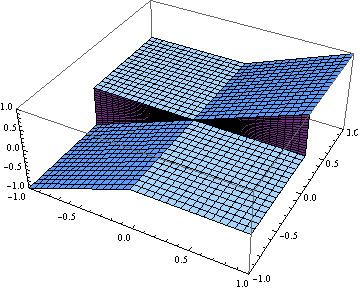 | ||
In mathematics, a homogeneous function is one with multiplicative scaling behaviour: if its argument is multiplied by a factor, then its value is multiplied by some power of this factor.
Contents
- Example 1
- Linear functions
- Homogeneous polynomials
- Minmax
- Polarization
- Rational functions
- Logarithms
- Affine functions
- Positive homogeneity
- Homogeneous distributions
- References
For example, a homogeneous function of two variables x and y is a real-valued function that satisfies the condition
More generally, if ƒ : V → W is a function between two vector spaces over a field F, and k is an integer, then ƒ is said to be homogeneous of degree k if
for all nonzero α ∈ F and v ∈ V. When the vector spaces involved are over the real numbers, a slightly less general form of homogeneity is often used, requiring only that (1) hold for all α > 0.
Homogeneous functions can also be defined for vector spaces with the origin deleted, a fact that is used in the definition of sheaves on projective space in algebraic geometry. More generally, if S ⊂ V is any subset that is invariant under scalar multiplication by elements of the field (a "cone"), then a homogeneous function from S to W can still be defined by (1).
Example 1
The function
suppose x = 2, y = 4 and t = 5
Linear functions
Any linear function ƒ : V → W is homogeneous of degree 1 since by the definition of linearity
for all α ∈ F and v ∈ V. Similarly, any multilinear function ƒ : V1 × V2 × ... Vn → W is homogeneous of degree n since by the definition of multilinearity
for all α ∈ F and v1 ∈ V1, v2 ∈ V2, ..., vn ∈ Vn. It follows that the n-th differential of a function ƒ : X → Y between two Banach spaces X and Y is homogeneous of degree n.
Homogeneous polynomials
Monomials in n variables define homogeneous functions ƒ : Fn → F. For example,
is homogeneous of degree 10 since
The degree is the sum of the exponents on the variables; in this example, 10=5+2+3.
A homogeneous polynomial is a polynomial made up of a sum of monomials of the same degree. For example,
is a homogeneous polynomial of degree 5. Homogeneous polynomials also define homogeneous functions.
Given a homogeneous polynomial of degree k, it is possible to get a homogeneous function of degree 1 by raising to the power 1/k. So for example, for every k the following function is homogeneous of degree 1:
Min/max
For every set of weights
Polarization
A multilinear function g : V × V × ... V → F from the n-th Cartesian product of V with itself to the underlying field F gives rise to a homogeneous function ƒ : V → F by evaluating on the diagonal:
The resulting function ƒ is a polynomial on the vector space V.
Conversely, if F has characteristic zero, then given a homogeneous polynomial ƒ of degree n on V, the polarization of ƒ is a multilinear function g : V × V × ... V → F on the n-th Cartesian product of V. The polarization is defined by
These two constructions, one of a homogeneous polynomial from a multilinear form and the other of a multilinear form from a homogeneous polynomial, are mutually inverse to one another. In finite dimensions, they establish an isomorphism of graded vector spaces from the symmetric algebra of V∗ to the algebra of homogeneous polynomials on V.
Rational functions
Rational functions formed as the ratio of two homogeneous polynomials are homogeneous functions off of the affine cone cut out by the zero locus of the denominator. Thus, if f is homogeneous of degree m and g is homogeneous of degree n, then f/g is homogeneous of degree m − n away from the zeros of g.
Logarithms
The natural logarithm
This can be proved by noting that
Affine functions
Affine functions (the function
Positive homogeneity
In the special case of vector spaces over the real numbers, the notion of positive homogeneity often plays a more important role than homogeneity in the above sense. A function ƒ : V {0} → R is positive homogeneous of degree k if
for all α > 0. Here k can be any real number. A (nonzero) continuous function homogeneous of degree k on Rn {0} extends continuously to Rn if and only if Re{k} > 0.
Positive homogeneous functions are characterized by Euler's homogeneous function theorem. Suppose that the function ƒ : Rn {0} → R is continuously differentiable. Then ƒ is positive homogeneous of degree k if and only if
This result follows at once by differentiating both sides of the equation ƒ(αy) = αkƒ(y) with respect to α, applying the chain rule, and choosing α to be 1. The converse holds by integrating. Specifically, let
Thus,
As a consequence, suppose that ƒ : Rn → R is differentiable and homogeneous of degree k. Then its first-order partial derivatives
One can specialise the theorem to the case of a function of a single real variable (n = 1), in which case the function satisfies the ordinary differential equation
This equation may be solved using an integrating factor approach, with solution
Homogeneous distributions
A continuous function ƒ on Rn is homogeneous of degree k if and only if
for all compactly supported test functions
for all t and all test functions
for all nonzero real t and all test functions
The substitution v = y/x converts the ordinary differential equation
where I and J are homogeneous functions of the same degree, into the separable differential equation
